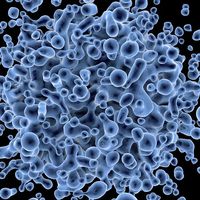CD47 Marker Inhibits Anti-Tumor Response in More Ways Than One
A characteristic of tumors includes the ability to avoid the immune system. In many cases tumors can progress without detection of immune cells. In the literature many scientists refer to undetectable tumors as ‘cold’ compared to immune responsive tumors, which are characterized as ‘hot’. Immune cells that target cancer or infected cells detect different proteins on their surface. These proteins send out a ‘danger’ signal to attack or a ‘safe’ signal in which the immune cells recognize the protein-expressed cell as a normal part of the body. Macrophages are a type of regulatory immune cell that monitors the body and surveys for infected cells or tumors. If macrophages detect ‘danger’ signals they will ‘eat’ or phagocytose the infected cell by engulfing it. This process of cell killing, or lysis is known as phagocytosis. However, in ‘cold’ tumors macrophages cannot detect cancer cells due to many reasons, including overexpression of CD47 on the tumor surface. CD47 is a protein which triggers SIRPα on macrophages to inhibit their function and lower the anti-tumor immune response. Therapeutic treatments blocking CD47 has been tested but result in toxicities as many other healthy cells also express this protein to avoid being phagocytosed by macrophages. Scientists are continuing to investigate how CD47 suppression works and how to better target this to optimize therapeutic efficacy.
A recent Nature Immunology article, from the lab of Dr. Andre Veillette at McGill University, discovered how CD47 further prevents phagocytosis in macrophages through a pathway independent of SIRPα. Interestingly, CD47 also inhibited phagocytosis through SLAMF7, which is a pro-phagocytic ligand. Importantly, the distinction was made that SIRPα was not involved in this phagocytosis inhibition. Veillette and others demonstrated that CD47 and SLAMF7 interact on the tumor cell (in cis) to increase the threshold needed for a ‘danger’ signal to be detected by macrophages.
Further investigation of this mechanism revealed that CD47-SLAMF7 interaction can be disrupted through CD47 blockade and a SLAMF7 agonist, which promotes SLAMF7 expression. In addition, CD47 blockade and SLAMF7 agonist did not interrupt SIRPα function, which allowed increased anti-tumor immunity. Importantly, freeing SLAMF7 from CD47, using a monoclonal antibody known as Z10, promoted phagocytosis making the tumor ‘hot’. The authors made use of multiple techniques to demonstrate this interaction including in vitro or studies performed in a dish and in vivo mouse studies where specific genes were knocked out. To improve translation of their findings, Veillette and others repeated their studies in human cell lines. Overall, this work has major implications for new therapeutic regimens in cancer patients.
Veillette and others demonstrated that CD47 further blocked phagocytosis by macrophages through a SIRPα-independent mechanism involving SLAMF7 in cis or on the surface of the tumor. More importantly, through this mechanistic discovery, it allowed new therapeutic options to be discovered to improve anti-tumor immunity. This is a major finding because previously CD47 targeted therapies resulted in high toxicities. Drug combination of anti-CD47 and a SLAMF7 agonist now allows macrophages to detect and phagocytose tumors. For the first time scientists have found a way to redirect macrophage phagocytosis toward ‘cold’ tumors to make them ‘hot’. This work provides further options to effectively target hard-to-treat tumors.
Nature Immunology, article, Andre Veillette, McGill University








